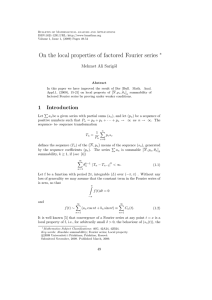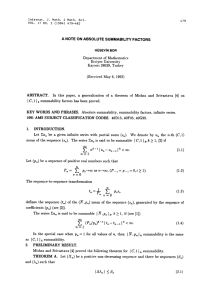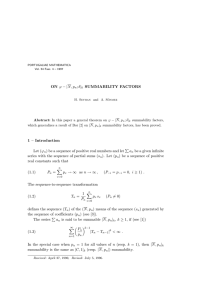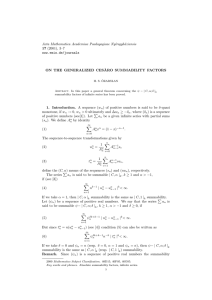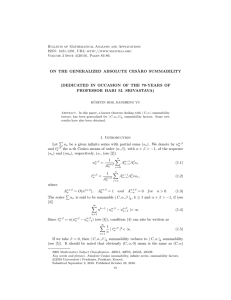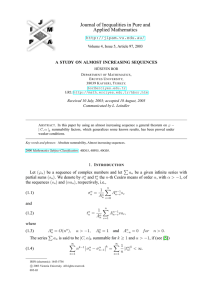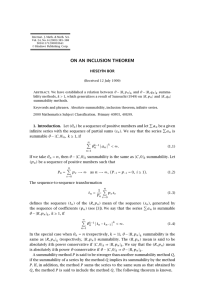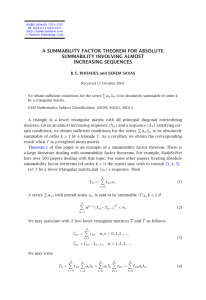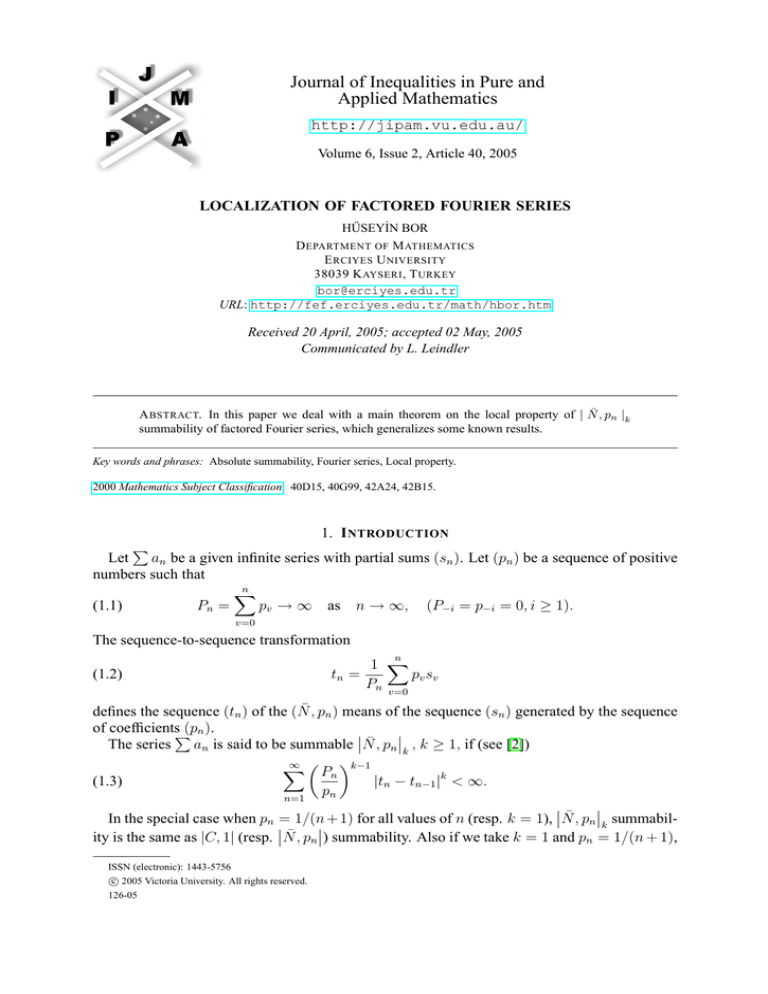
Journal of Inequalities in Pure and
Applied Mathematics
http://jipam.vu.edu.au/
Volume 6, Issue 2, Article 40, 2005
LOCALIZATION OF FACTORED FOURIER SERIES
HÜSEYİN BOR
D EPARTMENT OF M ATHEMATICS
E RCIYES U NIVERSITY
38039 K AYSERI , T URKEY
bor@erciyes.edu.tr
URL: http://fef.erciyes.edu.tr/math/hbor.htm
Received 20 April, 2005; accepted 02 May, 2005
Communicated by L. Leindler
A BSTRACT. In this paper we deal with a main theorem on the local property of | N̄ , pn |k
summability of factored Fourier series, which generalizes some known results.
Key words and phrases: Absolute summability, Fourier series, Local property.
2000 Mathematics Subject Classification. 40D15, 40G99, 42A24, 42B15.
1. I NTRODUCTION
P
Let an be a given infinite series with partial sums (sn ). Let (pn ) be a sequence of positive
numbers such that
n
X
(1.1)
Pn =
pv → ∞ as n → ∞, (P−i = p−i = 0, i ≥ 1).
v=0
The sequence-to-sequence transformation
(1.2)
tn =
n
1 X
p v sv
Pn v=0
defines the sequence (tn ) of the (N̄ , pn ) means of the sequence (sn ) generated by the sequence
of coefficientsP(pn ).
The series an is said to be summable N̄ , pn k , k ≥ 1, if (see [2])
k−1
∞ X
Pn
(1.3)
|tn − tn−1 |k < ∞.
pn
n=1
In the special case when pn = 1/(n + 1) for all values of n (resp. k = 1), N̄ , pn k summability is the same as |C, 1| (resp. N̄ , pn ) summability. Also if we take k = 1 and pn = 1/(n + 1),
ISSN (electronic): 1443-5756
c 2005 Victoria University. All rights reserved.
126-05
2
H ÜSEYIN B OR
summability N̄ , pn k is equivalent to the summability |R, log n, 1|. A sequence (λn ) is said
to be convex if ∆2 λn ≥ 0 for every positive integer n, where ∆2 λn = ∆λn − ∆λn+1 and
∆λn = λn − λn+1 .
Let f (t) be a periodic function with period 2π and integrable (L) over (−π, π). Without any
loss of generality we may assume that the constant term in the Fourier series of f (t) is zero, so
that
Z π
(1.4)
f (t)dt = 0
−π
and
(1.5)
f (t)∼
∞
X
(an cos nt + bn sin nt) ≡
n=1
∞
X
An (t).
n=1
It is well known that the convergence of the Fourier series at t = x is a local property of
the generating function f (i.e. it depends only on the behaviour of f in an arbitrarily small
neighbourhood of x), and hence the summability of the Fourier series at t = x by any regular
linear summability method is also a local property of the generating function f .
2. K NOWN R ESULTS
Mohanty [4] has demonstrated that the |R, log n, 1| summability of the factored Fourier series
X
(2.1)
An (t)
log(n + 1)
at t = x, is a local property of the generating function of f , whereas the |C, 1| summability of
this series is not. Matsumoto [3] improved this result by replacing the series (2.1) by
X
An (t)
(2.2)
, δ > 1.
{log log(n + 1)}δ
Generalizing the above result Bhatt [1] proved the following theorem.
P −1
Theorem A. If (λn ) is a convex
sequence
such
that
n λn is convergent, then the summaP
bility |R, log n, 1| of the series An (t)λn log n at a point can be ensured by a local property.
3. T HE M AIN R ESULT
The aim of the present paper is to prove a more general theorem which includes of the above
results as special cases. Also it should be noted that the conditions on the sequence (λn ) in our
theorem, are somewhat more general than in the above theorem.
Now we shall prove the following theorem.
Theorem
3.1. Let k ≥ 1. If (λn ) is a non-negative
sequence such that
and non-increasing
P
P
pn λn is convergent, then the summability N̄ , pn k of the series An (t)λn Pn at a point is a
local property of the generating function f .
We need the following lemmas for the proof of our theorem.
P
Lemma 3.2. If (λn ) is a non-negative and non-increasing sequence such that
pn λn is convergent, where (pn ) is a sequence
of
positive
numbers
such
that
P
→
∞
as
n
→ ∞, then
n
P
Pn λn = O(1) as n → ∞ and Pn ∆λn < ∞.
J. Inequal. Pure and Appl. Math., 6(2) Art. 40, 2005
http://jipam.vu.edu.au/
L OCALIZATION OF FACTORED F OURIER S ERIES
3
Proof. Since (λn ) is non-increasing, we have that
m
m
X
X
Pm λm = λ m
pn = O(1)
pn λn = O(1)
n=0
as
m → ∞.
n=0
Pm
Applying the Abel transform to the sum n=0 pn λn , we get that
m
m
X
X
Pn ∆λn =
pn λn − Pm λm+1 .
n=0
n=0
Since λn ≥ λn+1 , we obtain
m
m
X
X
Pn ∆λn ≤ Pm λm +
p n λn
n=0
n=0
= O(1) + O(1) = O(1)
as
m → ∞.
Lemma 3.3.
P Let k ≥ 1 and sn = O(1). If (λn ) is a non-negative and non-increasing sequence
such that pn λn is convergent,
of positive numbers such that Pn →
P where (pn ) is a sequence
∞ as n → ∞, then the series an λn Pn is summable N̄ , pn k .
P
Proof. Let (Tn ) be the sequence of (N̄ , pn ) means of the series an λn Pn . Then, by definition,
we have
n
v
n
1 X
1 X X
Tn =
pv
ar λ r P r =
(Pn − Pv−1 )av λv Pv .
Pn v=0 r=0
Pn v=0
Then, for n ≥ 1, we have
Tn − Tn−1
n
pn X
=
Pv−1 Pv av λv .
Pn Pn−1 v=1
By Abel’s transformation, we have
Tn − Tn−1
n−1
n−1
pn X
pn X
=
Pv Pv sv ∆λv −
P v s v p v λv
Pn Pn−1 v=1
Pn Pn−1 v=1
n−1
pn X
−
Pv pv+1 sv λv+1 + sn pn λn
Pn Pn−1 v=1
= Tn,1 + Tn,2 + Tn,3 + Tn,4 ,
say.
By Minkowski’s inequality for k > 1, to complete the proof of Lemma 3.3, it is sufficient to
show that
∞
X
(3.1)
(Pn /pn )k−1 |Tn,r |k < ∞, for r = 1, 2, 3, 4.
n=1
Now, applying Hölder’s inequality with indices k and k 0 , where k1 + k10 = 1 and k > 1, we get
that
( n−1
)(
)k−1
m+1
m+1
n−1
X Pn k−1
X
X
X
p
1
n
|Tn,1 |k ≤
|sv |k Pv Pv ∆λv
Pv Pv ∆λv
.
p
P
P
P
n
n
n−1
n−1
n=2
v=1
n=2
v=1
Since
n−1
X
Pv Pv ∆λv ≤ Pn−1
v=1
J. Inequal. Pure and Appl. Math., 6(2) Art. 40, 2005
n−1
X
Pv ∆λv ,
v=1
http://jipam.vu.edu.au/
4
H ÜSEYIN B OR
it follows by Lemma 3.2 that
1
n−1
X
Pn−1
v=1
Pv Pv ∆λv ≤
n−1
X
Pv ∆λv = O(1)
as n → ∞.
v=1
Therefore
m+1
X
n=2
Pn
pn
k−1
k
|Tn,1 | = O(1)
m+1
X
n−1
pn X
|sv |k Pv Pv ∆λv
Pn Pn−1 v=1
n=2
= O(1)
m
X
|sv |k Pv Pv ∆λv
v=1
= O(1)
m
X
m+1
X
pn
P P
n=v+1 n n−1
Pv ∆λv = O(1)
as m → ∞,
v=1
by virtue of the hypotheses of Theorem 3.1 and Lemma 3.2. Again
( n−1
)(
)k−1
m+1
n−1
m+1
X pn
X
X
X Pn k−1
1
k
k
|Tn,2 | ≤
|sv | (Pv λv )k pv
pv
p
P
P
Pn−1 v=1
n
n
n−1
n=2
v=1
n=2
= O(1)
m+1
X
v=2
= O(1)
m
X
n−1
pn X
|sv |k (Pv λv )k pv
Pn Pn−1 v=1
k
k
|sv | (Pv λv ) pv
v=1
= O(1)
m
X
|sv |k (Pv λv )k
v=1
= O(1)
= O(1)
m
X
v=1
m
X
m+1
X
pn
P P
n=v+1 n n−1
pv
Pv
|sv |k (Pv λv )k−1 pv λv
pv λv = O(1)
as m → ∞,
v=1
in view of the hypotheses of Theorem 3.1 and Lemma 3.2. Using the fact that Pv < Pv+1 ,
similarly we have that
m+1
m
X Pn k−1
X
k
|Tn,3 | = O(1)
pv+1 λv+1 = O(1) as m → ∞.
pn
n=2
v=1
Finally, we have that
k−1
m X
Pn
n=1
pn
k
|Tn,4 | =
m
X
|sn |k (Pn λn )k−1 pn λn
n=1
= O(1)
m
X
pn λn = O(1)
as m → ∞,
n=1
by virtue of the hypotheses of the theorem and Lemma 3.2. Therefore, we get that
k−1
m X
Pn
|Tn,r |k = O(1) as m → ∞, for r = 1, 2, 3, 4.
p
n
n=1
J. Inequal. Pure and Appl. Math., 6(2) Art. 40, 2005
http://jipam.vu.edu.au/
L OCALIZATION OF FACTORED F OURIER S ERIES
This completes the proof of Lemma 3.3.
5
In the particular case if we take pn = 1 for all values of n in Lemma 3.3, then we get the
following corollary.
Corollary 3.4. Let P
k ≥ 1 and and sn = O(1). If (λnP
) is a non-negative and non-increasing
sequence such that λn is convergent, then the series nan λn is summable |C, 1|k .
Proof of Theorem 3.1. Since the behaviour of the Fourier series, as far as convergence is concerned, for a particular value of x depends on the behaviour of the function in the immediate
neighbourhood of this point only, hence the truth of Theorem 3.1 is a consequence of Lemma
3.3. If we take pn = 1 for all values of n in this theorem, then we get a new local property result
concerning the |C, 1|k summability.
R EFERENCES
[1] S.N. BHATT, An aspect of local property of |R, log n, 1| summability of the factored Fourier series,
Proc. Nat. Inst. Sci. India, 26 (1960), 69–73.
[2] H. BOR, On two summability methods, Math. Proc. Cambridge Philos Soc., 97 (1985), 147–149.
[3] K. MATSUMOTO, Local property of the summability |R, log n, 1|, Tôhoku Math. J. (2), 8 (1956),
114–124.
[4] R. MOHANTY, On the summability |R, log w, 1| of Fourier series, J. London Math. Soc., 25 (1950),
67–72.
J. Inequal. Pure and Appl. Math., 6(2) Art. 40, 2005
http://jipam.vu.edu.au/

